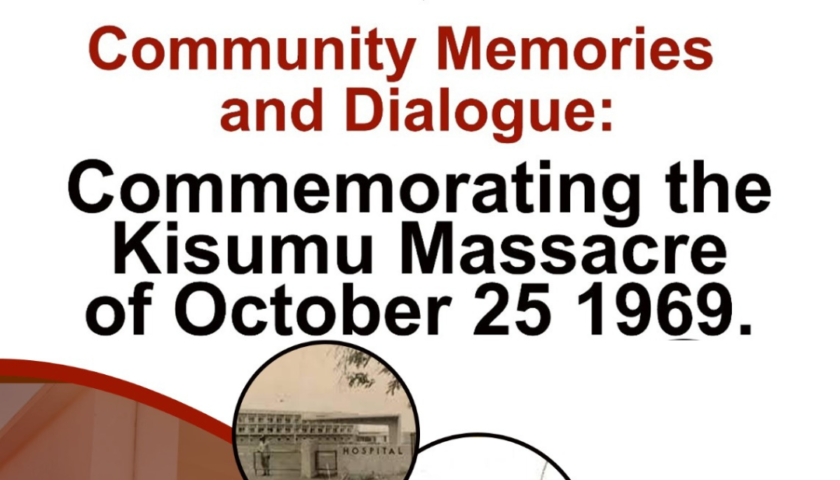On the 25th of October 1969, a somber event unfolded in Kisumu, Kenya, etching a painful chapter into the nation’s history. The Kisumu Massacre, an incident marked by the shooting of innocent civilians, predominantly Luos, by paramilitary police (GSU) and security forces, remains a harrowing reminder of a turbulent period in Kenya’s past.
The Mama Grace Onyango Memorial Hall will host the commemoration of this tragic event on its anniversary in 2023. As we prepare to remember and reflect upon the Kisumu Massacre, let us delve into the background and the circumstances that led to this fateful day.
A Tumultuous Time
The 1960s were a tumultuous period in Kenyan history. The country had just gained independence, and the struggle for power and influence was fierce. Jomo Kenyatta, the first President of Kenya, had been released from detention in 1961 with the efforts of Jaramogi Oginga Odinga, who had advocated for his release to take up leadership.
While Kenyatta enjoyed broad support across various ethnic groups, both he and Odinga were seen as the leaders of their respective communities: Kenyatta representing the Kikuyu and Odinga representing the Luo. This ethnic dimension added complexity to an already intricate political landscape.
A Nation Divided
The Cold War was at its zenith, and global superpowers sought to influence local policies and gain allies, creating a proxy Cold War in Kenya. Local politics became intertwined with these ideological divisions. Odinga and his ally Bildad Kaggia criticized the Kenyatta government for implementing a corrupt land redistribution policy that left the poor and landless marginalized.
The political landscape became further polarized with the assassination of Pio Gama Pinto, a freedom fighter and Odinga’s chief tactician with ties to the Eastern Bloc. His death in 1965 marked Kenya’s first political assassination and heightened tensions.
The Formation of KPU and Government Crackdown

As Odinga became increasingly marginalized within the government, he resigned and founded his own political party, the Kenya People’s Union (KPU). Several members of Parliament defected from the ruling party, KANU, to join KPU, resulting in a by-election in 1966 that saw KPU members, including Bildad Kaggia, lose their seats outside Nyanza Province.
In response to the rise of KPU, the government swiftly passed the Security Act in July 1966, allowing for detention without trial. This legislation was immediately employed against KPU members, further escalating political tensions.
Assassinations and Unrest
The situation worsened with the arrest and detention without trial of key KPU members, including Ochola MakAnyengo, Oluande Koduol, and Peter Ooko. Simultaneously, members of the Luo community in government began losing their positions. The suspicious deaths of Argwings Kodhek and Tom Mboya, both allies of Odinga, added fuel to the fire.
Tom Mboya, who was regarded as the heir apparent to Kenyatta, was assassinated just six months after Argwings Kodhek’s death in July 1969. These events plunged the country into political turmoil and heightened tensions across ethnic lines.
The Kisumu Massacre
Four months after Tom Mboya’s assassination, President Kenyatta visited Kisumu to inaugurate the newly built New Nyanza Provincial General Hospital, which had received funding from Russia. The president aimed to assert his authority in Nyanza Province, which was marked by growing tension and support for KPU.
The atmosphere at the event quickly turned hostile, with the crowd openly challenging Kenyatta and expressing their support for KPU. Accusations were leveled at Kenyatta regarding Tom Mboya’s murder. In the midst of this heated atmosphere, an exchange of words occurred between Jaramogi Oginga Odinga and President Kenyatta.
The situation escalated dramatically when Kenyatta began insulting the Luo community in attendance, threatening to “crush” them and using derogatory language. In a moment of heightened emotions, a chair was thrown towards Kenyatta from the roof, narrowly missing him. A stampede ensued, and Kenyatta was swiftly evacuated by his security team.
As Kenyatta made his exit, the GSU security forces opened fire on the crowd, resulting in a tragic loss of life. Official government sources reported 11 fatalities, but other accounts suggest that the true number may have been closer to 100. Shockingly, some victims were shot 30 to 50 kilometers away from the epicenter of the riots, indicating that the security forces were indiscriminate in their use of force.
The Kisumu Massacre serves as a painful reminder of a dark period in Kenyan history, characterized by political tension, ethnic divisions, and violence. As we commemorate this tragic event, we must remember the lives lost and the suffering endured by the victims and their families. Reflecting on this somber history is crucial to ensure that such atrocities are never repeated, and that Kenya continues to strive for unity, peace, and justice.
Kennth Ochieng
KCN News Agency




